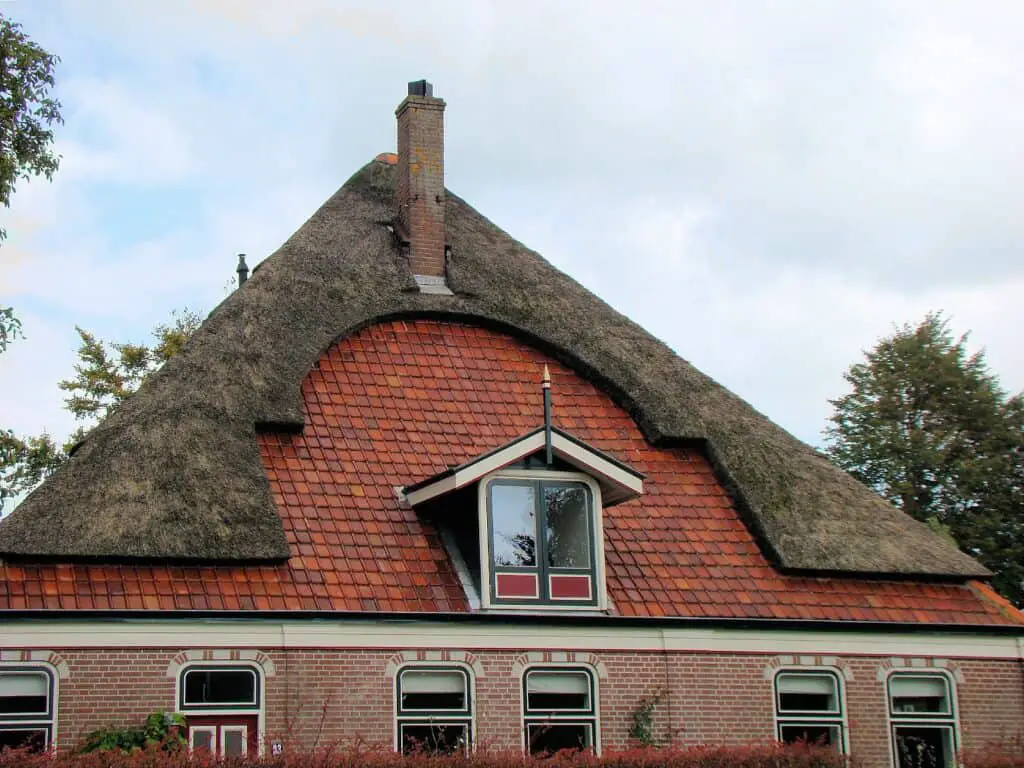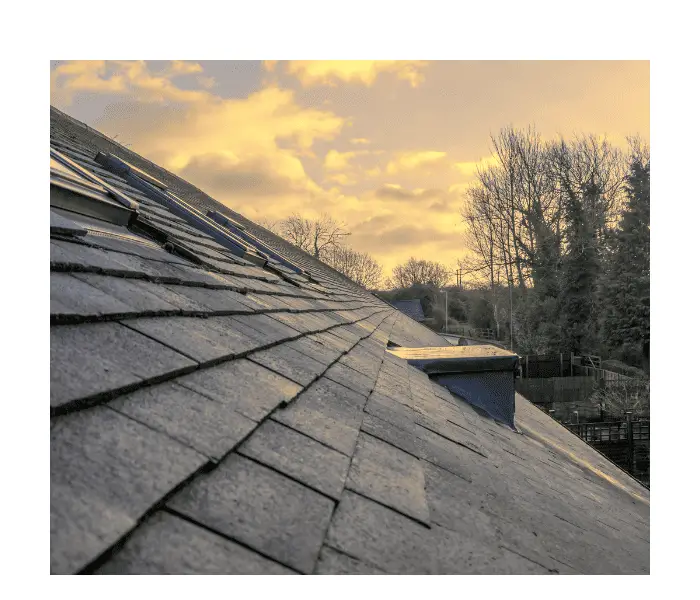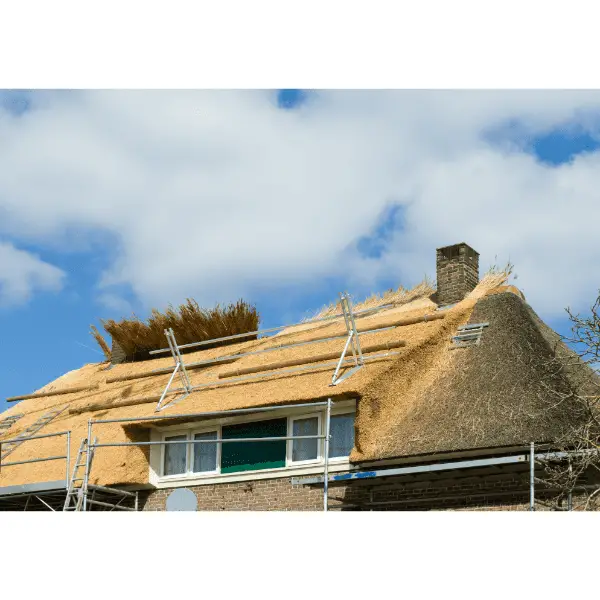Although a thatched roof looks great, it can be expensive to maintain. Due to it being made of organic materials, you need to replace the entire roof every 15-20 years or so.
Thinking about this leads us to what materials you can use for a roofing replacement and, by extension, can you tile a thatched roof? You can tile a thatched roof. The first step involves removing all the thatch to expose the roof’s structure before replacing it with tiles.
It’s worth noting, though, that it can be an incredibly long and expensive project.
In this article, we’ll look at what it takes to tile a thatched roof.
Can You Change a Thatched Roof to a Tiled Roof?
Replacing a thatched roof with tiles is perfectly possible. However, it’s a pretty long-winded process, and the steps involved can vary depending on the age and condition of the property.
Before looking into the details, let’s consider why you might want to change a thatched roof to tiles.
Unsurprisingly, the main reason is upkeep. Aside from occasional damage, tiled roofs are pretty much maintenance free.
The biggest concern is wind, which can knock tiles off your roof. However, this isn’t very common, and even when it does happen, you can expect to only lose a handful of tiles.
Thatch, on the other hand, can be expensive to maintain. As mentioned, it needs to be replaced every 20 years or so, although you might get a bit longer out of it depending on the materials used.
Also, replacing thatch isn’t a cheap job.
Tiles are also more durable than thatch. This shouldn’t be a shock, considering one is made of clay, slate or concrete, and the other is made of straw.
Depending on the materials used, tiles could even withstand falling off the roof without breaking. Regardless of how you look at it, tiles are a more durable option than thatch.
Then there’s the insurance aspect. If you live in a thatched cottage, you probably already know that it affects your home insurance policy.
Thatch is at greater risk of fire or environmental damage, which is an issue for insurers. As such, they pass this increased risk onto you as the homeowner.

Finally, we must consider the possibility of wildlife damage. It’s not uncommon for animals to take thatch as nesting material or to hunt in the thatch for food.
You might even find animals (such as mice) living in the thatch.
While there’s still a possibility of mice living in the attic of a tiled roof, the tiles themselves are pretty much impervious to wildlife damage.
If you live in a rural area, this can be a massive benefit because it drastically reduces the upkeep of your roof. Sure, you might still find the occasional bird nesting on your roof, but it’s easier to deal with.
Converting Thatch to Tile Roof UK
Now that we’ve looked at the why, let’s cover the how. This isn’t an exhaustive guide on how to replace thatch with tiles, but it should be detailed enough to give you an idea of what the process involves.
The first step is to have your roof assessed by a professional. They’ll let you know whether it’s actually possible to convert it, although it should be.
Whether your roof needs changing is a different matter.
Next, the thatch is stripped to expose the roofing timbers. These are what support the roofing material, and it’s necessary to get a good look at them before going any further.
For example, if your property is old, they might need repairing or replacing before you start thinking about what tiles you want.
It’s also likely that you’ll need additional support beams. As we discuss in a different article, thatch is considerably lighter than tiles.
In fact, it can be up to 50% lighter depending on the materials used. Regardless of the age of the beams, you might need extra to compensate for this extra weight.
Then it’s just a case of fitting the new roof. It’s not a quick process, although it’s arguably much simpler than replacing the thatching. Also, roofing is a more common profession, meaning you should have greater flexibility with the contractor you choose.
We don’t need to explain the process of building a tile roof here. Essentially, it involves putting in insulation, weather protection, and then the tiles.
You can expect this step to take a week or two depending on the size of your roof, how complicated the job is, and the weather. Overall, expect this to go on for a good month or so.
Types of Tiles Used
If you decide to replace your thatched roof with tiles, your overall options are:
· Concrete: highly durable, not super expensive
· Slate: classic look. Durability is questionable, and they’re quite heavy and expensive
· Terracotta: Fairly inexpensive, not super durable
· Plastic: Surprisingly durable and can be made to look like other materials. Also surprisingly expensive
When it comes to which tiles you choose, it’ll be best to speak to a roofer for their professional opinion on what would best suit your roof.

How Much Does it Cost to Replace a Thatched Roof with Tiles?
There’s no clear answer to this question because the cost can depend on numerous factors. However, you could expect to pay anywhere from £15,000 to £30,000 to replace a thatched roof with tiles.
It could be even more if your roof is large or if you want fancy tiles. You’ll probably have less flexibility with the beginning stages of the job, as you’ll want a professional thatcher to remove the existing roof.
However, when it comes to adding extra beams and building the tile roof, this is a more standard job. As such, you might be able to shop around for competitive quotes from a wider pool of contractors.
Generally, though, it’ll be in your best interest to choose a roofer who has experience working with older buildings. They have certain quirks that can catch people off guard, and it’ll be best if the roofer has at least a basic idea of how to deal with them.
It might mean paying a bit extra, but it’ll arguably be worth it compared to fixing potential mistakes later down the line.
Do You Need Planning Permission to Replace a Thatched Roof with Tiles?
This is a bit of a difficult question to answer, as it’ll depend specifically on the property in question. That said, it’ll pretty much be a yes, as changing the roof will count as a major change to the building.
While it’s not on the same level as building an extension (the standard example given), it’ll be pretty difficult to argue that changing the roof type isn’t a major change.
The best thing to do is to contact your local planning authority, as they’ll advise you accordingly about your specific building and project. It’s also the department you apply for planning permission for, so this should be fairly straightforward.
However, you’re not always guaranteed to be accepted. There are plenty of reasons why it might be refused, including impacts on your neighbours, clashes with policies, and more. If your planning permission is rejected, you’ll be told why.
Thatched Roof Tiles
We haven’t even touched on a more important aspect of replacing a thatched roof with tiles: listed buildings. The chances of your thatched cottage being a listed building are pretty high (around 75% of them are), and this will have a big impact on your plans.
In short, unless your thatched cottage was built within the last century or so, you’ll be automatically barred from replacing the roof. It’s thanks mainly to the fact that these buildings will be listed – at least in part – because of their roofs.
Listed buildings hold some kind of special or historical interest, and thatch is a pretty good excuse for preservation.
Also, within the listing guidelines, homeowners are banned from removing the building’s existing features. And what is the thatched roof if not an existing feature?
It’s worth noting that this won’t be a blanket rule, though. After all, 75% of thatched cottages are listed, meaning 25% aren’t. In theory, anyone living in an unlisted thatched cottage should be fine to replace their roof, providing they can planning permission to do so.
Either way, your first step should be to contact your local planning authority. They’ll advise you of whether your property is listed (which you should already know) and what your next steps could be to get the roof replaced.
Can you Remove a Thatched Roof?
Removing a thatched roof is indeed possible, but it’s a complex task and typically requires professional expertise. It’s not just a matter of tearing off the thatch; instead, it involves careful removal to prevent damaging the underlying structure of the roof.
It’s also crucial to consider the disposal of the thatch, which is a bio-degradable material. In some cases, underlying timbers may be exposed and could potentially be damaged during the process, which might necessitate further repairs.
For these reasons, and due to the unique skill set needed to work with thatched roofs, it’s highly recommended to hire a professional thatcher.
If replacement is the objective, various options can be explored, including re-thatching or substituting with an entirely different roofing material, like tiles. In either case, a structural assessment might be needed to ensure the building can support the new load.

Do you Need Planning Permission to Remove a Thatched Roof?
Whether planning permission is required to remove a thatched roof often depends on local laws and the specific circumstances surrounding the property.
If the building is listed or located within a conservation area, it’s more likely you will need permission. Listed building consent will be required for any works to the thatch or ridge.
Even for unlisted buildings, it’s generally prudent to consult with your local planning authority. This is due to the fact that changing from a thatched to a different type of roof can significantly alter the appearance and character of the building, and these changes may fall under planning control.
Furthermore, the process might involve structural alterations, which can also require permission. Therefore, before embarking on a roof conversion project, it’s advisable to gain a clear understanding of the planning regulations in your area, and ensure all necessary permissions are in place.
The consequences of failing to do so can be serious, potentially leading to fines or legal action.
Final Thoughts on Replacing Thatched Roofs with Tiles
So, replacing a thatched roof with tile is perfectly possible from a practical angle. However, getting permission might be a challenge depending on the age of your home.
Plus, if you do, it’s a pretty expensive project that might take a long time to offset the cost of simply getting it re-thatched every 20 years.
Living in a thatched cottage comes with a lot of responsibility, least of all preservation of British heritage. It’s not a decision to be taken lightly, so you should decide well in advance whether you’re happy to care for a thatched roof.


